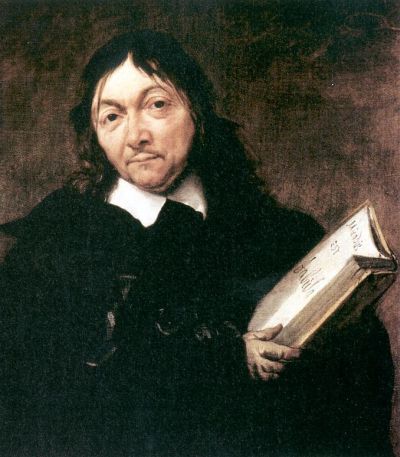Think that you may own a portrait of René Descartes? We authenticate, appraise, research and issue certificates of authenticity (COA) and provide consultations for all portraits of René Descartes.
The number of authentic portraits of René Descartes in existence, beyond the most stringent and conservative verdict of two, remains an open question of ongoing inquiry. Descartes, often called the “Father of Modern Philosophy,” was a French mathematician, scientist and philosopher. Second perhaps only to his famous words “Cogito, ergo sum,” he is widely credited with the invention of analytic geometry (what we now call the Cartesian coordinate system being introduced in La Géométrie of 1637, as an appendix to his remarkable Discourse de la methode). Descartes was a central figure in the scientific revolution of the 16th and 17th centuries, and in the early-modern rejection of many longstanding ancient and medieval philosophical doctrines. Excepting his earliest scientific treatise (The World, withheld from publication after Galileo's condemnation in 1633), Descartes's account of the foundations of natural science in Principles of Natural Philosophy (1644) would become a chief target of Isaac Newton and others; in philosophy, his arguments in Meditations on First Philosophy (1641) set the agenda for more than a century of subsequent philosophical reflection and debate. Like all authentic images of world-changing figures, portraits of Descartes are important both as historical records and as works of art. Our present, “visual” idea of Descartes's likeness owes almost entirely to the famous and well-recognized painting by Frans Hals (Portrait #1), to be found in the Louvre.

Portrait #1, The Hals Portrait, 1649/50, Musée du Louvre
Oils after Hals (c. 1580 Antwerp - 1666 Haarlem), some quite early, are known. Given the high regard in which both the famed Haarlem artist and the French scientist-philosopher were held in Europe, other copies may surface, as may presently-untraced or -unknown portraits. Certainly collectors and dealers, no less than museums, will be alert to the fact that Descartes's shadow in Europe was widely cast - even beyond France, the Netherlands, and Sweden (all claiming his residency at some time, and each boasting portrait artists from accomplished to minor). The noted Dutch painter Jan-Baptist Weenix (1621 Amsterdam - c. 1660 near Utrecht) executed the following portrait of Descartes around 1648:

Portrait #2, Jan-Baptist Weenix, c. 1648, Centraal Museum, Utrecht
The contrast between these two portraits is striking, and instructive: artistic portrayals of René Descartes illustrate the challenges of authentication, and the importance of research. The iconic and oft-reproduced Hals portrait (#1) is now in the reserve collection of the Louvre, on evidence that it is neither by Hals nor of Descartes. The Weenix painting (#2) is doubtless authentic.
Other artistic renderings exist, with a claim to Descartes as their subject. These include both paintings and engravings, both contemporaneous and posthumous, authentic and doubtful, traced and untraced, from an ad vivum sitting to a faithful copy. Among paintings are those by Sébastien Bourdon (1616 - 1671) also in the Louvre, and a portrait with notably contrasting features at the Musee des Augustins in Toulouse, by an unknown hand of the French School. Among engravings are the earliest by Frans van Schooten (the younger, 1615 - 1660), after his own drawing of 1644, and the much different but familiar portrait engraving by Jonas Suyderhoef (1613 - 1686) after Hals of 1649/50. There too the contrasts give scholars and collectors pause. In respect of date, a painting by David Beck (Dutch c. 1621 - 1656), almost certainly the one commissioned by Queen Christina in Sweden and in the possession of their Academy of Sciences, is, if not contemporaneous, contemporaneous-enough (executed soon before, or soon after, Descartes's death there in February 1650). The authentic Schooten plate evidently yielded early engravings far rarer than those from re-worked states; the line-engravings of Balthasar Moncornet (c. 1600 - 1668) and François Jollain (c. 1641 - 1704) are portraits after Schooten, evidently in single states but less easy to date. Predictably, there are many engravings after Hals - or, as the case would be, after Suyderhoef - ranging widely from rare to common: perhaps the earliest is that of Cornelis van Dalen (the elder, 1602 - 1665).
While the likelihood is low that authentic pictures of René Descartes will surface, it must be emphasized that the art-historical accounting of Descartes portraiture is an incomplete and challenging one. Witness, for example, that the painting owned by abbot Le Monnier, after which Charles Adam commissioned Achille Jacquet's engraving of Descartes in 1904, has gone untraced following sale upon Le Monnier's death. And while we know that Descartes's Haarlem friend Augustin Bloemaert commissioned a portrait of him in 1646, and it remains altogether unclear whether that likeness was rendered by Hals or someone else.
Are you wondering about a portrait in your family collection? It could be a likeness of Descartes. Art Experts Inc. is prepared to help: we welcome and encourage you to contact us. Our team of experts can provide reliable research on any work of art.
Being aware that no definitive iconographic study of René Descartes exists, Art Experts Inc. has commissioned a scholarly review of the subject. We have decided to make it available, for our readers, as an illustration of the professional resources at our disposal, and of the kind of research we can undertake. We hope you find it interesting and informative.
